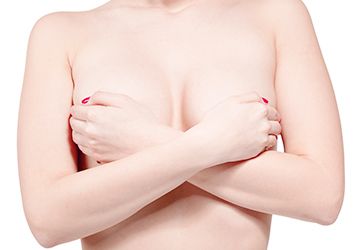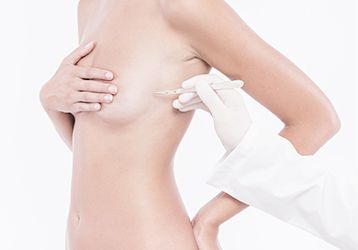Tissue Expander & Direct-to-Implant Reconstruction w/ AlloMend

Overview
Breast reconstruction can also be accomplished by using prosthetics, implanted devices. With this method, the final reconstruction consists of a permanent breast implant, either silicone or saline, positioned under the skin and pectoralis muscle. Generally speaking, implant-based reconstruction can be done in multiple stages or as a single step.
Staged Expander-Implant
In the staged method, a device known as a tissue expander is placed at the initial operation. This can be placed simultaneously as the mastectomy or at a later date, in a delayed fashion. Two to three weeks after surgery, the tissue expander is gradually inflated by adding saline to the device. This is done in the outpatient setting and continued until the expander is filled to the desired size. This first stage’s main goal is to expand the skin and create a pocket where the permanent implant will ultimately reside.
The second stage involves the removal of the tissue expander and placement of the permanent implant. This is usually an outpatient procedure and involves less recovery time than the initial operation.
Single-Stage or Direct-to-Implant
A traditional mastectomy procedure removes the breast tissue and skin, leaving a relatively flat surface on the chest. In such cases, the staged approach with initial tissue expansion is necessary to expand the skin and create a permanent implant space. Other mastectomy techniques, such as the skin-sparing and nipple-sparing procedures, remove mainly the breast tissue while leaving much of the skin of the breast and chest intact. If an adequate amount of skin is spared, it is sometimes possible to avoid the initial expander stage and place the permanent implant at the time of mastectomy. This approach is also known as a direct-to-implant breast reconstruction. The ideal candidate for such an approach is typically a smaller cup size patient with excellent skin quality that can be evaluated at physical examination. The direct-to-implant reconstruction is only possible immediately after the mastectomy and not an option for patients seeking a Breast Reconstruction Timing.
Acellular Dermal Matrix
The tissue expander and implant method may, in some cases, require the use of a biologic implant known as the Acellular Dermal Matrix. This material is derived from the skin of either animals or cadavers and is treated to contain no living cells. Instead, it serves as a biologic scaffold, or sheet, that can be used to facilitate the reconstruction. While several products are available, we prefer to use AlloMend by AlloSource. This biologic material has a unique shaped, meshed pattern that not only optimizes tissue ingrowth but allows it to smoothly cover the tissue expander or implant. We have developed novel techniques using this product as shown in the videos below.
In both the staged and direct-to-implant methods, the prosthesis is placed under the pectoralis muscle. In its natural, uninterrupted state, the pectoralis muscle sits closely on the chest wall, and there is very little space between these two structures. Additionally, the lower attachments of the pectoralis muscle to the chest wall are generally higher than the breast crease’s natural position (inframammary fold). Therefore, dividing these lower attachments can allow for improved positioning of the tissue expander or implant and more space under the muscle making it possible to accommodate a larger device volume. However, when cut, the lower part of the muscle retracts upwards and creates a gap between the muscle and the chest wall. This is where the acellular dermal matrix is placed, essentially forming a bridge or sling between the lower, cut edge of the muscle and the chest wall. Once placed, the biologic material is gradually replaced by the ingrowth of one’s own cells and tissue and does not need to be removed later.
Request Your Consultation
To learn more about tissue expander or direct to implant reconstruction with AlloMend ADM, you can schedule an appointment online or you can call 855-687-6227
*The information available on this page was created to educate our patients. It is not an alternative for a formal consultation with a board-certified plastic and reconstructive surgeon. Individual results vary per patient. For more information, we strongly recommend scheduling a consultation with our doctors.


